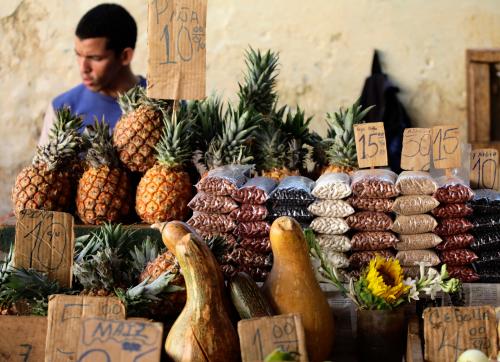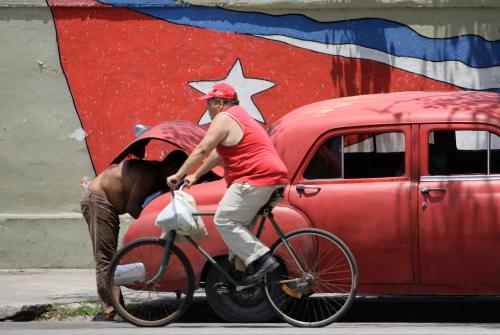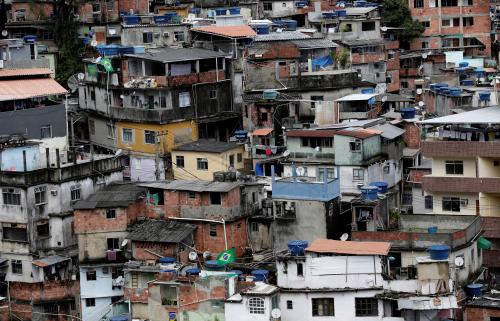The last two decades have been a period of deep social transformation in most of Latin America. A prolonged commodity boom powered above-average growth in the region during the 2000s, which contributed to an overall reduction of poverty and an expansion of the middle-class. Though this is already having an effect on how governments cope with new social demands, in the long term the rise of the middle class in Latin America represents a fundamental change in the society and public institutions of these countries. The middle class in Latin America comprises almost 200 million people (one out of every three individuals), which is the second largest proportion among developing regions just after Eastern Europe. Moreover, the size of the middle class has doubled since 2001. This is remarkable considering that the number of middle class Latin Americans had remained flat for the last two decades of the 20th century.
There is no doubt that new social demands emerging from this sector of society will deeply reshape the debate on the public agenda for reforms, particularly on those priorities for public spending and democracy. However, some important questions remain unanswered: How irreversible is the rise of this new middle class? Are their values and preferences clearly different from those of other segments of society? How do those preferences compare to other developing regions? Are their preferences and values determined by self-perception—the idea of belonging to the middle class—or are they instead influenced by Latin America’s cultural and institutional settings?
In other words, is there anything unique about the rise of the middle class in Latin America when compared to other developed and developing regions? Based on recent research, we argue that the Latin American middle class is quite similar to other emerging middle classes around the world, although somewhat more aspirational and less materialistic. However, the middle class in the region is still vulnerable to a reversal of the economic fortunes of Latin America. Taken together, this suggests that Latin American governments will have to work hard to meet the public policy demands of this growing segment of their populations or risk a backlash from citizens worried that their new found prosperity will not translate into future quality of life.
Why focus on the middle class?
The relevance of the middle class as a key factor for development is related to a well-accepted idea: lower inequality and a growing middle class can become a stepping stone to achieve higher levels of development. After a certain income threshold is passed, the possibilities to invest in goods that improve long-run growth perspectives increases substantially. In particular, savings and investments in durable goods such as housing and human capital become a main concern to this new middle class. This segment of society can also enhance development prospects due to an expansion of consumption capacity and changes of preferences that lead them to demand more complex and higher quality goods. There are also other arguments that claim the emergence of this middle class can promote an entrepreneurship environment that bolsters the creation of new firms, contributing to better job opportunities and enhanced productivity. As a consequence, economic activity is expected to expand even further.
However, this debate should not be limited to the impact that the expansion of the middle class can have on income levels or more generally on economic growth. Its rise is also complemented by shifts in attitudes and preferences that can influence the political and social realms. For example, the emerging middle class:
- Promotes certain attitudes toward working and saving;
- Prompts the surge and stabilization of democratic regimes;
- Constitutes a source of political stability as this sector of society is more predisposed to be ideologically moderate;
- Can be a basis for social cohesion, reducing tensions between lower and upper classes;
- Helps introduce reforms aimed human capital accumulation and better governance.
Arguments about the benefits of a growing middles class also have their detractors. For some critics, the rise of the middle class is a process that is both disruptive and non-linear. Certainly, the upsurge of the middle class can move in tandem with certain desirable attitudes and preferences; but in a context of weak institutions unable to tackle more complex social demands, the middle class can also turn into a source of political instability. The limited capacity of the state to respond to more sophisticated social demands, the restricted capacity to introduce reforms to improve legitimacy, and institutional limitations to uphold popular support for a new public policy agenda can be detrimental for social and political change. This social transformation can become conflictive precisely because the middle class might start to support non-democratic stances on the political and social spheres. Therefore, perhaps some of the “desirable” effects of the rise of the middle class, i.e. its democratic impulse, can take place only when a broad social alliance between the middle class and working and lower class sectors exists.
What kind of middle class does Latin America have?
In Latin America, and certainly in other developing regions, this debate is particularly complex due to the ambiguity with which we identity and quantify this segment of society. Moreover, the (perhaps false) assumption that income growth is the main mechanism driving social change disregards the possibility that self-perception of membership in the middle class might have an even larger impact on public policy preferences. Self-perception may also explain group cohesion—a key factor in mobilizing demands based on the grievances of this sector. Thus, tackling the debate over the Latin American middle class requires a holistic approach that incorporates the objective information provided by income measures, along with survey data more focused on values and preferences. Even though both perspectives are not easy to harmonize as they measure different dimensions of the same social phenomenon, they have to be used together to understand (not always explain) the distinctive characteristics of this process.
In a recent report by CAF Development Bank of Latin America, Michael Penfold and Guillermo Rodríguez outline three important findings about the region’s emerging middle classes. First, even though economic growth and government policy has expanded both the buying capacity and welfare prospects for important segments of society, many of those individuals are still vulnerable to falling back into poverty. The vulnerable group is the most numerous of the region, representing 39 percent of the total population. It constitutes a great challenge for public policy formulation as efforts on the expansion and outreach of safety nets and productive inclusion in job markets have to be undertaken to reduce vulnerability. This also needs to be complemented with policies to address those segments within the middle classes that are more consolidated and demand better quality of public services. The expansion of both groups will require broadening and strengthening institutional capacities, whether private or public, directed to address these increasingly complex and distinctive social demands.
Second, Latin America’s middle class is highly aspirational: more than half of the people consider themselves part of the middle class, even though just one out of every three could be placed objectively in this social segment. This is a characteristic that is almost absent in other developing regions. Subsequently, the question that arises is why do people in Latin America consider themselves part of the middle class? The two most relevant factors are educational attainment and savings: achieving an additional educational level increases the probability to consider oneself as middle class by 3.54 percent; while being able to save increases the probability by 12.19 percent. Nonetheless, in comparison to other developing regions, the impact of these two factors is smaller in Latin America, which likely reflects lower returns on education or cultural biases towards saving.
Third, the Latin American middle class does not have particularly distinctive values and preferences in comparison to other developing regions. Specifically, the Latin American middle class is ideologically moderate but slightly more inclined to the left than other regions; it has the lowest levels of social capital and trust in institutions among developing regions, even though countries like Uruguay and Argentina show levels higher than those of Eastern Europe. Overall, the Latin American middle class is not very politically active, whether one evaluates the least active, Guatemala, or the most active, Brazil. Moreover, it is very polarized over the role of the state on social protection, paradoxically with Venezuela as most favoring individual responsibility and El Salvador as most favorable to a state role. It is usually in favor of market rules, where the Dominican Republic stands out for is pro-market orientation. Nevertheless, the Latin American middle class does have an important difference with the rest of the world: it is considerably more inclined to post-materialistic views. By this, we mean that the Latin American middle classes are more inclined to focus on social goods, such as quality of life, than the acquisition of material possessions. The latter is not a peculiarity of Latin America’s middle class, but a characteristic of its society as a whole. In this aspect Uruguay, Colombia, and Argentina have the most post-materialistic middle classes of the region.
What does this mean for the future of Latin America?
Latin America faces prospects of slower growth for the next two to three years. Unlike previous slow-downs, this is unlikely to provoke serious economic crises in most countries in the region. By and large, macroeconomic management has greatly improved, and many countries have reasonably large foreign exchange reserves that should allow them to weather a period of slower growth. However, some countries have continued to adopt poor policy choices that have produced high rates of inflation and shortages of foreign exchange. But there will be pressure on all governments to rationalize and restrict spending, potentially provoking competition among those elements of society that seek support from the state.
In countries with well-managed economies, slow growth is mostly a threat to the vulnerable elements of the middle class. This group, which identifies with the aspirations of the broader middle class, tends to have less accumulated wealth to buffer variations in income. This segment is therefore more vulnerable to reductions in salaries and wages that accompany periods of slow growth. In countries such as Brazil, where consumer credit expanded rapidly during the boom period, high levels of indebtedness can accentuate the sense of crisis produced by declining income. Beyond the middle class, the vulnerable class tends to rely to a greater extent on government transfer programs covering higher education, healthcare and retirement, unlike wealthier elements of society that rely to a greater extent on private providers.
In such cases, the growing gap between income and aspirations may produce social protest and mobilization, as we saw in Chile, Peru, Colombia, Brazil and Venezuela in 2013 and 2014. The impact on countries in the midst of elections during 2014 was clear, with Chile’s new president promising education reform and Brazil’s incumbent president facing a strong challenge from a reinvigorated opposition. The growing gap between self-identification and dwindling income will inevitably produce a negative reaction in a very significant sector of society, especially among vulnerable segments of the middle class.
In countries with poor macroeconomic management, all elements of the middle class, as well as the poor, will feel the impact of the crisis. The vulnerable classes are most likely to slip back into poverty for lack of accumulated resources to cushion the effects of economic contraction. Poor macroeconomic policy typically reflects a broader lack of state capacity, so governments are unlikely to be able to target remaining resources on poor and marginalized members of society. And even more traditional, well-established elements of the middle class will run down their accumulated stocks of wealth if the crisis persists for a sufficient duration. This all points to a volatile political and social panorama for these states during the present economic slowdown.
Recent government responses to middle class demands highlight the ambiguous impact the middle class has on improved governance. In response to social protests, the Chilean government has pushed for education reform, promising free university education, and Brazil has maintained subsidies to transport and energy. On the surface, it is hard to criticize additional investments in education or healthcare, particularly in states with mediocre service provision in these sectors. There is also hope that discontent focused on poor government performance will produce reforms. However, responding to the interests of the middle class may reinforce spending patterns, such as broad subsidies, that mainly benefit already well-off sectors of the society at the expense of more targeted programs that concentrate spending on the most vulnerable. This pattern of spending is particularly problematic as states face reduced resources.
Nor is their broad evidence that political parties in Latin America are up to the task of providing the glue that holds together the middle, vulnerable and poor classes in an environment of shrinking resources. Political parties and party systems have been under stress and deteriorating in some countries of the region, and they may not be capable of managing the social tensions between middle and other classes. In Chile, the governing parties have been able to mobilize political support for wide-ranging fiscal reform that may provide resources for the state to continue to address demands from a range of social actors. In Peru, Colombia and Brazil, as well as Argentina and Venezuela, we have instead seen highly polarized politics, both in terms of street protests and in recent elections.
In the end, Latin America’s middle class will not, on its own, determine the future course of the region. Nor does their present role in politics offer clear insight into their impact on governance outcomes, positive or negative. But the rapid expansion of this class across the region, and the even larger proportion of persons who self-identify as middle class, does mean that governments have a different problem set to address as they craft public policy responses. While the region experienced broad and sustained economic growth, rising incomes satisfied many of the demands that the middle class might have made of the state. In a situation where economic trends are increasingly negative, this class will increasingly turn to the state at a time when states have fewer resources to satisfy both middle class demands and those of the most vulnerable in society.
Michael Penfold and Guillermo Rodríguez’s recent CAF report on Latin America’s emerging middle classes is available here.
The Brookings Institution is committed to quality, independence, and impact.
We are supported by a diverse array of funders. In line with our values and policies, each Brookings publication represents the sole views of its author(s).










Commentary
Prospects for Latin America’s middle class after the commodity boom
February 10, 2015